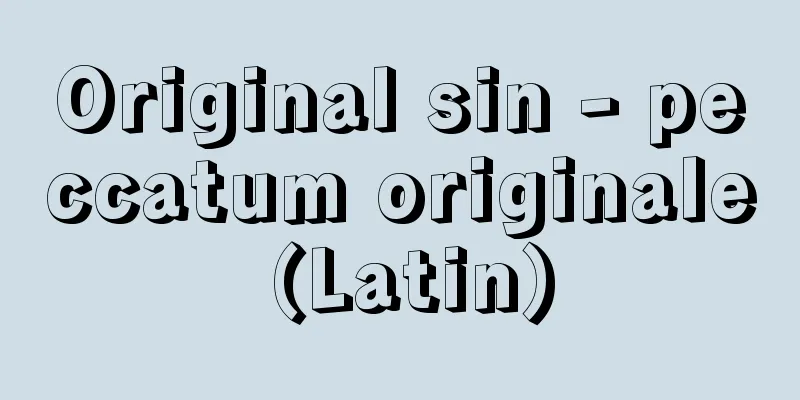Great Migration - Völkerwanderung (German: Great Migration)

|
Inspired by the westward advance of the Huns at the end of the 4th century, Germanic groups migrated in large numbers into the Roman Empire, and after the fall of the Western Roman Empire, they settled in various parts of the empire and established kingdoms, a process that lasted for over 200 years until the end of the 6th century. It is also called the "German invasions" or "Barbarian invasions." [Shosuke Hirajo] CauseIn the narrow sense, the Great Migration refers to the process mentioned above, but since the 1st millennium BC, the Germanic peoples had been moving south from their native land in the southern part of the Scandinavian Peninsula and the Baltic Sea coast, repeating a process of slow migration and settlement, and had spread from the Germania region east of the Rhine and north of the Danube to the northern shore of the Black Sea. Furthermore, since the invasion of the Cimbri and Teutonic peoples at the end of the 2nd century BC, they had often attempted to invade the Roman Empire, and even after the invasion of Italy by the Lombards at the end of the 6th century AD, there were the Normans (a group of North Germanic peoples such as Danes, Norwegians, and Swedes) from the 8th to the 11th centuries into various parts of Europe, their colonization of Iceland, and the founding of Kievan Rus (these are the activities of the so-called Vikings, also known as the second great migration of peoples). In the broader sense, it is a long-term phenomenon that lasted for about 2000 years. The Great Migration in the narrow sense mentioned above is the period when the scale and speed of migration were particularly remarkable, and therefore, although there is no doubt that the direct cause was the oppression of the Huns, we must consider that the phenomenon of the so-called Great Migration was brought about by a combination of internal factors of the Germanic peoples themselves, particularly more general factors such as land shortages due to population growth, and factors on the side of the Roman Empire, such as the weakening of military power and the resulting decline in border defense capabilities. Regarding the last mentioned situation on the side of Rome, it is necessary to take into account the fact that a large part of the Roman army at the end of the Empire was made up of Germanic mercenaries, and that the dissatisfaction of the lower classes who suffered under the oppression of the autocratic rule of the late Empire, which coincided with the Great Migration, manifested itself in the form of rebellions against the Empire, such as the Bagaudae rebellion in Gaul, and the Germanic people were rather welcomed as liberators. [Shosuke Hirajo] ProgressAround the middle of the 2nd century, the East Germanic Visigoths settled on the north bank of the lower Danube River, while the Ostrogoths settled to the east, on the north bank of the Black Sea. Meanwhile, the Huns, a nomadic horse-riding people from the steppes of Central Asia, began to move westward around the 2nd century and appeared in Europe, subjugating the Iranian Alans of the Volga and Don river basins, and moving further westward to defeat the Ostrogoths in 375, bringing most of the tribes under their control. Some of the neighboring Visigoths fled under the leadership of Athanarich, while others sought protection in the Roman Empire under the leadership of the Fritigern brothers, and with the permission of the eastern Roman Emperor Valens, they crossed the Danube River in 376 and migrated to Moesia and Thrace. This is the event generally considered to be the beginning of the Great Migration. However, the land they were given was of poor quality, and on top of that they were oppressed by Roman officials, so they rebelled against Rome, defeating the Roman army at the Battle of Adrianople in 378 and defeating Emperor Valens. The rebellion subsided as a result of the pro-Germanic policies of his successor, Theodosius I, but after Alaric was elected King of the Visigoths, they rebelled again in 395, plundering various parts of the Balkan Peninsula, and invaded Italy in 401, sacking the city of Rome for three days. In response to this, the Western Roman Empire recalled its garrison on the Rhine border to defend mainland Italy, and many Germanic groups began to move into the Roman Empire one after another. The Frankish Salians, who lived in the lower Rhine basin, advanced from Toxandria into northern Gaul, and at the end of the 5th century under Clovis I, integrated not only the Salians but also other Frankish groups (Libarians and Camabites) to establish the Frankish Kingdom. The Burgundians, who lived in the Main basin, advanced from the middle Rhine basin into central Gaul and established the Burgundian Kingdom, but it was destroyed by the Huns and moved to the Savoy region under the leadership of Gundbeck to rebuild the kingdom (443). Furthermore, the Vandals, who lived in Hungary, along with some of the Alamanni and Suebi, passed through Gaul and entered Spain, where they settled for a time, but were oppressed by the Visigoths, who had founded a state in southern France, and under the leadership of Gaiseric, crossed the Straits of Gibraltar and established the Vandal Kingdom in the former site of Carthage in North Africa. Meanwhile, the Visigoths ravaged various parts of Italy, waiting for an opportunity to cross into Africa, but after the death of Alaric, his successor Ataulf made a complete turn and headed for Gaul, establishing the Visigothic Kingdom (Kingdom of Tolosa) centered in Toulouse in southern France, oppressing the Vandals and spreading his influence into Spain. The Huns continued to advance westward after conquering the Ostrogoths, and under Attila at the end of the 5th century, they established a large empire centered around Hungary by subjugating the surrounding Germanic groups, and showed signs of invading Gaul, but were repelled by an alliance of the Western Roman army and Germanic groups under the command of General Aetius, and after Attila's death (453), the empire rapidly collapsed, with many of the groups under its control becoming independent. Among them, the Ostrogoths, under the leadership of Theodoric, at the request of the Eastern Roman Emperor, invaded Italy to defeat Odoacer, a Germanic mercenary commander who had dethroned Western Roman Emperor Romulus Augustulus (476, the fall of the Western Roman Empire) and seized control of Italy, and established the Ostrogothic Kingdom. In addition, a group of Saxons who had spread to northwestern Germany migrated to Britain in the first half of the 5th century together with the Angles and Jutes, and created many small kingdoms there (the so-called Heptarchy), which gradually showed signs of unification. Finally, the Lombards gained independence from the Huns in the middle Danube basin, and took possession of Pannonia and Noricum, but after the fall of the Ostrogothic Kingdom, they invaded Italy (568) and established the Lombard Kingdom, centered in northern Italy. [Shosuke Hirajo] significanceThere is no doubt that the Great Migration marked the beginning of the Middle Ages, as the center of history shifted from the Mediterranean coast to Europe, especially Western Europe, and the bearers of civilization were replaced by Germanic peoples. However, the assessment that the invasion of so-called "barbarians" caused the sudden decline of ancient culture and the beginning of the Dark Ages, which began with Renaissance humanists and continued until the 19th century, is no longer supported today. Rather, it should be considered that they inherited ancient culture to a large extent, created a mixed Roman-Germanic culture, and laid the foundation for the development of European culture after the Middle Ages. Regarding the nature of the migration, it is necessary to distinguish between the East Germanic groups (Eastern Goths, Visigoths, Vandals, etc.) who migrated long distances from their indigenous lands, and the West Frankish groups (Franks and others) who migrated and connected to their indigenous lands. While the latter were accompanied by the migration of peasants, the former were centered on warrior groups led by leaders, and it is estimated that the ratio of Roman residents in the new settlements did not exceed 5%. Politically, they did not necessarily reject Roman sovereignty, and many of them were allies of Rome, and land occupation was carried out through peaceful division in accordance with the Roman military garrison laws. Domestic governance, particularly administrative matters, was also heavily dependent on Roman officials, a typical example being the Ostrogothic Kingdom, which appointed Cassiodorus and Boethius. Recent research has drawn attention to the surprisingly strong Roman influence in terms of laws and institutions as well. On the Germanic side, on the other hand, the Great Migration marked a remarkable expansion of royal power, and it is also important to note that this progress in political integration promoted the formation of larger groups or kingdoms. [Shosuke Hirajo] "The Formation of the Western World" by Yamanaka Kenji (1968, Tokai University Press)" ▽ "Studies in Medieval Western Social History" by Masuda Shiro (1974, Iwanami Shoten)" ▽ "Germany and Rome" by Nagatomo Eizaburo (1976, Sobunsha)" ▽ "The Birth of the European World" by H. Pirenne, translated by Nakamura Hiroshi and Sasaki Katsumi (1960, Sobunsha)" ▽ "The Invasion of the Barbarians" by P. Richet, translated by Kuno Hiroshi (1974, Hakusuisha)" ▽ "Attila and the Huns" by L. Ambiss, translated by Anzai Kazuo (1973, Hakusuisha)" ▽ "The Great Germanic Invasion as Seen in Literature" by P. Courcel, translated by Naoki Keitaro (1974, Tokai University Press)" ▽ "The Rise and Fall of the Ostrogoths" by Matsutani Kenji (1994, Hakusuisha) [References] | | | |©Shogakukan "> The Great Migration (375-476) Source: Shogakukan Encyclopedia Nipponica About Encyclopedia Nipponica Information | Legend |
|
4世紀末フン人の西進に触発されて、ゲルマン系の諸集団が大規模にローマ帝国領内に移住し、西ローマ帝国の滅亡を経て帝国領内の各地に定住、諸王国を建設する6世紀末までの200年余の過程をさす。「ゲルマン人の侵入」German invasions(英語)、「蛮族の侵入」Barbarian invasions(英語)ともよばれる。 [平城照介] 原因狭義の民族大移動は上述の経過をいうが、ゲルマン民族はすでに紀元前1000年紀以来、先住地のスカンジナビア半島南部、バルト海沿岸地方から、緩慢な移動・定住の過程を繰り返しながら南下し、ライン川以東、ドナウ川以北のゲルマニア地域から、黒海北岸にまで広がっていた。さらに前2世紀末のキンブリ、テウトニ人の侵入以来、ローマ帝国にもしばしば侵入を試みていたし、紀元後6世紀末のランゴバルド人のイタリア侵入以後も、8世紀から11世紀ごろまでのノルマン人(デーン人、ノルウェー人、スウェーデン人などの北ゲルマン系の集団)のヨーロッパ各地への侵入、およびアイスランドへの植民、キエフ・ロシアの建国など(これらがいわゆるバイキングの活動で、第二の民族大移動ともよばれる)があり、広義には前後2000年ほどにも及ぶ長期の現象である。 上述の狭義の民族大移動とは、そのなかで移動の規模、スピードなどがとくに著しかった時期であり、したがってその直接の原因が、フン人の圧迫によることは疑いないとしても、ゲルマン民族自体の内部事情、とくに人口増加による土地不足などの、より一般的な原因や、さらにローマ帝国側の事情、すなわち軍事力の弱体化に伴う国境防衛力の低下などの諸原因が重なって、いわゆる民族大移動という現象を惹起(じゃっき)したと考えねばならない。とくに最後にあげたローマ側の事情に関して、帝政末期のローマ軍のかなりの部分が、ゲルマン系の傭兵(ようへい)軍によって占められていた事情や、ガリアにおけるバガウダエの反乱のように、後期帝政の専制的支配体制の下で重圧に苦しんでいた下層民の不満が、民族大移動と重なって帝国への反乱という形で表面化し、ゲルマン人はむしろ解放者として迎えられた事情なども考慮する必要があろう。 [平城照介] 経過2世紀なかばころ、東ゲルマン系の西ゴート人はドナウ川下流北岸に、東ゴート人はその東、黒海北岸に定住していた。他方、中央アジアのステップ地帯の遊牧騎馬民族であるフン人は、2世紀ごろから西進を始めてヨーロッパに姿を現し、ボルガ、ドン両川流域のイラン系アラン人を服属させ、さらに西進して375年東ゴート人を破り、部族民の大部分を支配下に入れた。隣接していた西ゴート人の一部はアタナリッヒの指導の下に逃れ、他の一部はフリティゲルン兄弟の指導の下にローマ帝国に保護を求め、東のローマ皇帝ウァレンスの許可を得て、376年ドナウ川を渡り、モエシア、トラキア地方に移住した。これが一般に民族大移動の発端とされる事件である。だが与えられた土地は地味(ちみ)が悪く、そのうえローマの役人の圧迫が重なったため、ローマに対し反乱を起こし、378年アドリアノープルの戦いでローマ軍を破り、皇帝ウァレンスを敗北させた。後を継いだテオドシウス1世が親ゲルマン政策をとった結果、反乱は収まったが、アラリックが西ゴート国王に選ばれたのち、395年ふたたび反乱を起こし、バルカン半島各地を略奪したすえ、401年イタリアに侵入、3日間にわたりローマ市を略奪した。 西ローマ帝国は、これに対抗してイタリア本土を防衛するため、ライン川国境の守備軍団を召還したので、多くのゲルマン系集団が、次々とローマ帝国内に移動を開始した。ライン川下流域にいたフランク系サリ人は、トクサンドリアから北ガリアに進出し、5世紀末、クロービス1世のもとで、サリ人だけでなく、他のフランク系集団(リブアリ人、カマビー人)をも統合してフランク王国を建てた。また、マイン川流域に居住していたブルグント人は、ライン川中流域からガリア中部に進出し、ブルグント王国を建てたが、フン人に滅ぼされ、グンドベックの指導下にサボイア地方に移って王国を再建した(443)。さらにハンガリー地方にいたバンダル人は、アラマン人やスエビ人の一部とともにガリアを経てスペインに入り、一時ここに定着したが、南フランスに建国した西ゴート人から圧迫され、ガイセリックの指導下にジブラルタル海峡を渡り、北アフリカのカルタゴの故地にバンダル王国を建てた。他方西ゴート人は、イタリア各地を荒らし、アフリカに渡る機会をうかがったが、アラリックの死後、後継者アタウルフは一転してガリアに向かい、南フランスのトゥールーズを中心に西ゴート王国(トロサ王国)をつくり、バンダル人を圧迫してスペインに勢力を広げた。 フン人は、東ゴート征服後も西進を続け、5世紀末ごろのアッティラのとき、ハンガリーを中心に周辺のゲルマン系諸集団を服属させて大帝国を樹立し、ガリア侵入の勢いを示したが、アエティウス将軍指導下の西ローマ軍とゲルマン諸集団との連合勢力に撃退され、アッティラの死(453)後、急速に瓦解(がかい)し、支配下の諸集団の多くは独立した。なかでも東ゴート人は、テオドリックの指導下、東ローマ皇帝の委嘱を受けて、西ローマ皇帝ロムルス・アウグストゥルスを廃位(476、西ローマの滅亡)してイタリアの支配権を奪っていたゲルマン系の傭兵隊長オドアケルを討つため、イタリアに侵入し、東ゴート王国を建てた。また、北西ドイツに広がっていたサクソン人の一派は、アングル人、ジュート人とともに5世紀前半ブリテン島に渡り、ここに多くの小王国(いわゆる七王国(ヘプターキー))をつくり、しだいに統合の動きを示した。最後にランゴバルド人もドナウ川中流域でフン人から独立し、パンノニア、ノリクムを領有したが、東ゴート王国の滅亡したあとのイタリアに侵入し(568)、北イタリアを中心にランゴバルド王国を建てた。 [平城照介] 意義民族大移動は、その結果として歴史の中心舞台が地中海沿岸からヨーロッパ、とくに西ヨーロッパに移り、文明の担い手もゲルマン人にかわったという点で、中世の開幕を告げる事件であったことに疑問の余地はないが、いわゆる「蛮族」の侵入によって古代文化が一挙に没落し、暗黒時代が始まったとする、ルネサンス期の人文主義者に端を発して19世紀まで続いた「評価」は、現在では支持されない。むしろ、古代文化を大幅に継承して、ローマ的・ゲルマン的混合文化を創出し、中世以降のヨーロッパ文化発展の基礎を置いたと考えるべきであろう。移動の様相については、先住地から長距離の移動を行った東ゲルマン系諸集団(東ゴート、西ゴート、バンダル人など)と、先住地に接続して移動を行った西フランク系諸集団(フランク人ほか)とを区別することが必要で、後者が農民層の移住も伴ったのに対し、前者では、指導者を中核とする戦士集団が移動の中心であり、新定住地におけるローマ系住民との比率は5%を超えなかったと推定される。政治的にも、かならずしもローマの宗主権を否定したわけでなく、多くはローマとの同盟関係の下に、土地占取もローマの軍隊駐屯法に従った平和的な土地分割が行われた。国内統治においても、とくに行政面ではローマ系官吏に依存する点が多く、カシオドルスやボエティウスを登用した東ゴート王国がその典型である。最近の研究では、法や制度の面においても意外とローマ的影響の強いことが注目されている。他方ゲルマン人の側では、民族大移動を契機として王権の伸張が著しく、また政治的統合が進んで、より大きな集団あるいは王国の形成が促進されたことも重要である。 [平城照介] 『山中謙二著『西欧世界の形成』(1968・東海大学出版会)』▽『増田四郎著『西洋中世社会史研究』(1974・岩波書店)』▽『長友栄三郎著『ゲルマンとローマ』(1976・創文社)』▽『H・ピレンヌ著、中村宏・佐々木克巳訳『ヨーロッパ世界の誕生』(1960・創文社)』▽『P・リシェ著、久野浩訳『蛮族の侵入』(1974・白水社)』▽『L・アンビス著、安斉和雄訳『アッチラとフン族』(1973・白水社)』▽『P・クルセル著、尚樹啓太郎訳『文学にあらわれたゲルマン大侵入』(1974・東海大学出版会)』▽『松谷健二著『東ゴート興亡史』(1994・白水社)』 [参照項目] | | | |©Shogakukan"> 民族大移動の経過(375~476年の諸… 出典 小学館 日本大百科全書(ニッポニカ)日本大百科全書(ニッポニカ)について 情報 | 凡例 |
<<: Ethnic clothing - Minzokufuku
>>: Ethnic sports - Minzoku Sports
Recommend
Nucleoprotamine
... refers to a complex formed in a cell by the b...
New insurance - Shinshuhoken
A general term for all types of non-life insuranc...
Ambedkar - Bhimrao Ramji Ambedkar
Indian social reform activist and politician. He ...
Guinea gold coin - Guinea
The name of an old British gold coin minted from 1...
Chokin - Chokin
〘Noun〙 ("覲" means audience) 1. When feud...
Akilaria - Akilaria
…Frankincense and myrrh are lumps of fragrant, ru...
Alhazen - Alhazen
The Latin name of Ibn al-Haytham. Source: About Sh...
Sambucus williamsii (English spelling) Sambucuswilliamsii
…[Hiroshi Aramata]. … *Some of the terminology th...
Gill Arch
In higher vertebrates, the gill slits do not open...
angiomatous nevus
…However, the pale pink spots often seen on the u...
Gypsophila paniculata (English name) Gypsophilapaniculata
… [Eiichi Asayama]. … *Some of the terminology th...
Saturn (mythology) (English spelling) Saturn
…The largest moon, Titan, has a large atmosphere ...
Principia Mathematica
Co-authored by A.N. Whitehead and BAW Russell. 3 v...
Long-eared bat
It is an animal of the order Chiroptera, family V...
Smuts, Jan Christiaan (Christian)
Born: May 24, 1870, Riebeekwest [Died] September 1...









